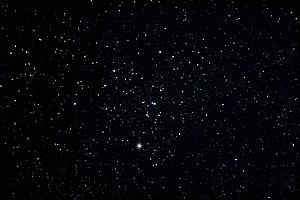| Hyades Cluster | |
|---|---|
 Photograph of the Hyades Cluster | |
| Observation data (J2000.0 epoch) | |
| Right ascension | 4h 27m |
| Declination | +15° 52′ |
| Distance | 153 ly (47 pc[1][2][3][4]) |
| Apparent magnitude (V) | 0.5 |
| Apparent dimensions (V) | 330′ |
| Physical characteristics | |
| Mass | 400 M☉ |
| Radius | 10 light-years (core radius) |
| Estimated age | 625 million years |
| Closest open cluster | |
| Other designations | Caldwell 41, Cr 50, Mel 25 |
| Associations | |
| Constellation | Taurus |
The Hyades (/ˈhaɪ.ədiːz/; Greek Ὑάδες, also known as Caldwell 41, Collinder 50, or Melotte 25) is the nearest open cluster and one of the best-studied star clusters. Located about 153 light-years (47 parsecs)[1][2][3][4] away from the Sun, it consists of a roughly spherical group of hundreds of stars sharing the same age, place of origin, chemical characteristics, and motion through space.[1][5] From the perspective of observers on Earth, the Hyades Cluster appears in the constellation Taurus, where its brightest stars form a "V" shape along with the still-brighter Aldebaran. However, Aldebaran is unrelated to the Hyades, as it is located much closer to Earth (65 ly) and merely happens to lie along the same line of sight.
The five brightest member stars of the Hyades have consumed the hydrogen fuel at their cores and are now evolving into giant stars.[6] Four of these stars, with Bayer designations Gamma, Delta 1, Epsilon, and Theta Tauri, form an asterism that is traditionally identified as the head of Taurus the Bull.[6] The fifth of these stars is Theta1 Tauri, a tight naked-eye companion to the brighter Theta2 Tauri. Epsilon Tauri, known as Ain (the "Bull's Eye"), has a gas giant exoplanet candidate,[7] the first planet to be found in any open cluster.
The age of the Hyades is estimated to be about 625 million years.[1] The core of the cluster, where stars are the most densely packed, has a radius of 8.8 light-years (2.7 parsecs), and the cluster's tidal radius – where the stars become more strongly influenced by the gravity of the surrounding Milky Way galaxy – is 33 light-years (10 parsecs).[1] However, about one-third of confirmed member stars have been observed well outside the latter boundary, in the cluster's extended halo; these stars are probably in the process of escaping from its gravitational influence.[1]
- ^ a b c d e f Cite error: The named reference
Perrymanwas invoked but never defined (see the help page). - ^ a b Cite error: The named reference
vanleeuwen09was invoked but never defined (see the help page). - ^ a b Cite error: The named reference
majaess11was invoked but never defined (see the help page). - ^ a b Cite error: The named reference
mcarthur11was invoked but never defined (see the help page). - ^ Bouvier J, Kendall T, Meeus G, Testi L, Moraux E, Stauffer JR, James D, Cuillandre J-C, Irwin J, McCaughrean MJ, Baraffe I, Bertin E. (2008) Brown dwarfs and very low mass stars in the Hyades cluster: a dynamically evolved mass function. Astronomy & Astrophysics, 481: 661-672. Abstract at http://adsabs.harvard.edu/abs/2008A%26A...481..661B.
- ^ a b Jim Kaler. "Hyadum I". Jim Kaler's Stars. Retrieved 29 October 2013.
- ^ Cite error: The named reference
Satowas invoked but never defined (see the help page).